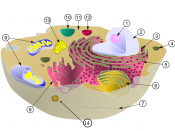The nucleus is the most obvious organelle in a eukaryotic cell. Virtually all eukaryote cells have a nucleus (red blood cells lose theirs and so are enucleate for most of their life-span of 180 days). It is surrounded by the nuclear envelope, a double membrane with contains a large number of pores. Molecules enter and leave the nucleus by these pores. The two lipid bilayers of the double membrane are separated by a gap of 20 to 40 nm, called the perinuclear space.
The nucleus contains the cell's DNA. This complex molecule carries the information, which the cell needs to divide and carry out all its cellular processes. Inside eukaryotic cells, the DNA is associated with histone proteins, and is called chromatin. When the DNA is transcribed into RNA the structure of the chromatin changes to allow the RNA polymerase enzyme to access the DNA strand. When the cell divides to form new cells, the chromosomes coil up more tightly than usual.
The chromosomes are moved to opposite ends of the cell so that, when the cell splits, each daughter cell receives the correct amount of DNA. You can click to find out more about cell division.
Nuclei also have a nucleolius. These darkly staining, crescent-shaped structures produce ribosomes by producing ribosomal RNA and packaging it with ribosomal proteins. The nucleus and ribosomes work together in the cell to synthesise proteins. You can click to find out more about protein synthesis.
Mitochondria are large organelles, which are shaped a bit like fat sausages. Mitochondria are sometimes called the 'power stations' of the cell because they burn up food molecules, in the presence of oxygen, to release energy in a process called aerobic respiration. The inner membrane of the mitochondria is folded into cristae, which give a large surface area for...


